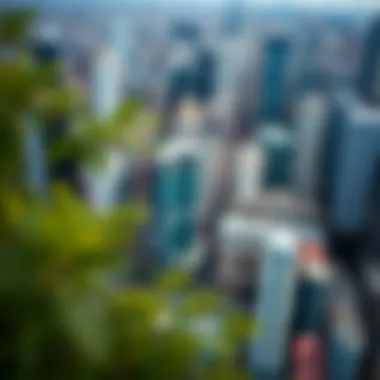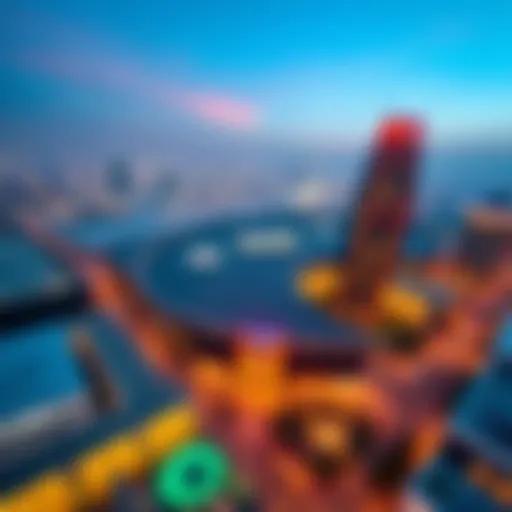Exploring CBDs and Their Role in Global Cities


Intro
The concept of a Central Business District (CBD) is intrinsically tied to the notion of international cities. CBDs are typically located at the heart of urban areas, acting as economic powerhouses that attract both investment and talent. This dynamic nature creates a complex fabric of social and commercial interactions, fueling the growth of cities on the international stage.
In exploring this concept, one must consider a multitude of factors. Economic activities, cultural exchanges, and infrastructural development intertwine to form vibrant urban landscapes that exemplify globalization. The emergence of cities like Dubai puts these aspects into suitable context, showcasing the evolution of CBDs in a globalized environment.
The following sections will peel back the layers of understanding around CBDs, examining market trends, diving into investment opportunities, and emphasizing the significance of these areas in the ongoing dialogue about urban development. Let’s embark on this detailed analysis that will perfectly suit investors, homeowners, agents, and analysts keen to deepen their understanding of international city concepts and their powerful CBDs.
Market Trends
As urban landscapes evolve, so do the market dynamics that define those environments. The real estate sector within CBDs reflects a myriad of market trends that are crucial for anyone looking to grasp the wider implications of these spaces.
Current Real Estate Landscape
The real estate landscape in CBDs, especially in cosmopolitan cities, is vibrant and continuously shifting. Areas that were once overlooked are swiftly transforming into hotspots for commerce and innovation. A notable example can be gleaned from Dubai, where former industrial zones have been reimagined into business-centric locales. Range of amenities, robust transport networks, and favorable governmental policies are crucial facilitators of these transitions.
The landscape is competing fiercely, with a mix of local and international players vying for prime real estate. Availability of luxury stores and dining options further enrich these districts, contributing to a more attractive environment for both businesses and individuals.
Property Price Trends
Property prices within these critical areas experience fluctuations that can reveal much about the economic sentiments in play. On the upward trajectory, new investments in infrastructure often lead to price surges, as seen in cities like London and Tokyo. Meanwhile, economic downturns can similarly deflate prices, oftentimes creating significant opportunities for buyers acting with foresight.
In a nutshell, keeping an eye on property price trends is essential. Alertness to these developments can guide investors toward timely decisions that optimize returns.
As urbanization progresses, an understanding of market fluctuations becomes imperative for stakeholders in the CBD landscape.
Investment Opportunities
In the context of CBDs, investment opportunities abound. A thorough examination of burgeoning sectors can help delineate areas with the highest potential returns, allowing astute investors to navigate these bustling environments effectively.
High-Return Areas
Certain neighborhoods within CBDs exhibit characteristics that make them particularly attractive for investment. For instance, areas that benefit from new urban projects or infrastructural improvements often yield higher returns. An example is the Downtown Dubai area, where a mix of residential and commercial properties has shown remarkable growth, thanks to heavy investment in infrastructure and amenities.
Upcoming Developments
With the tide of urban renewal and the continuous push to modernize, upcoming developments play a crucial role in shaping the future of CBDs. Projects that aim to enhance connectivity, sustainability, and livability in these districts can often signify the next wave of investment opportunities. Noteworthy projects in Dubai illustrate how planned developments, such as mixed-use precincts, are set to redefine existing landscapes and attract further business interests.
A cultivated understanding of these trends and opportunities will empower stakeholders in making informed decisions and leveraging the ongoing changes in the urban fabric of international cities. Cooperative learning and networking within relevant circles can be quite beneficial in grasping the full depth of these dynamics.
To delve deeper into the subject, resources such as Wikipedia and Britannica can provide further insights.
Prologue to Central Business Districts
Understanding Central Business Districts (CBDs) is crucial for grasping the intricate dynamics that underpin international cities. These urban centers are typically identified as the beating heart of a city's economic activity, housing major financial institutions, corporate headquarters, and an array of services that sustain both local and global business operations. The significance of CBDs extends beyond mere economics; they also act as cultural hubs, drawing people from various walks of life into a bustling environment where ideas and commerce converge.
The benefits of having a well-structured CBD are multifold. For investors, a thriving CBD can signal the potential for significant returns. It becomes a focal point where demand for real estate can increase due to proximity to amenities and infrastructure. Homeowners, too, can find value in properties located within these districts, as living close to a CBD often enhances one's lifestyle and connectivity. Furthermore, agents and analysts have a vested interest in CBDs because the health and growth of these areas can directly influence market trends and property values.
Concerning the considerations around CBDs, urban planners must navigate a complex set of challenges. From zoning laws to infrastructural demands, creating a sustainable and effective CBD requires a multifaceted approach. These areas must be designed not only for today's needs but also with an eye out for future growth. Mixed-use developments, which combine residential, commercial, and recreational spaces, are becoming more prominent, promoting a live-work-play balance that meets modern expectations.
Central Business Districts are not just economic engines; they are the cultural and social dynamo of cities, shaping the environment in which people live and work.
In summary, the discussion around CBDs anchors this article’s exploration of international city concepts. By illuminating their economic, cultural, and infrastructural elements, we better understand how these districts function as the backbone of urban centers worldwide.


Characteristics of an Effective CBD
The concept of an effective Central Business District, or CBD, extends beyond mere geographical boundaries. It stands as the heartbeat of any international city, having its fingers in nearly every pie of urban life. Without a doubt, the characteristics that define an effective CBD are pivotal in understanding its influence on the city’s overall economic, social, and infrastructural wellbeing.
Economic Drivers
First and foremost, the economic drivers of a CBD cannot be ignored. These areas typically host a plethora of businesses, ranging from multinational corporations to startups that have ambitions as high as the skyscrapers they inhabit. A thriving CBD acts as a magnet for investment, creating jobs for local residents and those from afar. For example, in Dubai, the financial district has attracted global giants such as Emirates NBD and Dubai Investments.
Some key points to consider include:
- Accessibility to Financial Services: An effective CBD provides robust financial services that cater to both individual consumers and corporations. It features banking institutions, stock exchanges, and other financial services critical for business operations.
- Real Estate Value: Locations in a high-demand CBD tend to see inflated property values. Investors flock here because they know the potential for appreciation is significant.
- Business Ecosystem: The interaction between various businesses in a CBD creates synergies that can lead to innovation and reduced operational costs.
Infrastructural Development
Switching gears, let’s dive into infrastructural development. An efficient CBD boasts state-of-the-art transport systems that facilitate smooth movement of people and goods. A well-connected transport network can make or break a CBD. Consider the Dubai Metro, which has revolutionized how residents and tourists navigate the city.
Infrastructural frameworks often include:
- Public Transport: Diverse transportation options like buses, subways, and trams reduce road congestion and contribute to sustainable urban mobility.
- Utilities and Services: Adequate water, electricity, and telecommunications services must be available to support both citizens and businesses.
- Public Spaces: Parks and recreational areas improve quality of life. They foster social interactions among residents and visitors, enriching the urban experience.
Cultural and Social Dynamics
One cannot underestimate the influence of cultural and social dynamics on a CBD’s effectiveness. A vibrant CBD embraces diversity and inclusivity. This melting pot of cultures fosters creativity and innovation, essential ingredients for a modern economy. Cities like New York or London have recognized this and prioritized arts and culture in their development plans, resulting in increased tourism.
Key to these dynamics are:
- Cultural Institutions: Museums, theaters, and galleries in a CBD add to its cultural richness, drawing both tourists and locals.
- Social Interactions: Cafés, restaurants, and public squares become venues where life happens, offering spontaneous encounters that can lead to networking opportunities or even partnerships.
- Community Engagement: Successful CBDs encourage local involvement through events and forums that allow citizens to voice their concerns and ideas, ultimately shaping the future of the area.
An effective CBD goes beyond being an economic hub; it is a melting pot that embodies the city's cultural ethos and future aspirations, ultimately driving continued investment and urban growth.
In summary, the characteristics of an effective CBD encompass economic viability, infrastructural robustness, and vibrant cultural dynamics. These elements work in tandem to create a space that not only supports businesses but also enriches the urban tapestry, ensuring that cities remain internationally competitive in a rapidly evolving marketplace.
The Role of CBDs in International Cities
Central Business Districts (CBDs) are more than just geographic zones; they serve as the lifeblood of international cities, influencing their economic vitality and cultural landscapes. In this segment, we will delve into the significance of CBDs, focusing on their integral roles in facilitating trade, tourism, and innovation. Recognizing these intersections helps to appreciate how cities compete on the global stage, drawing investments and fostering growth.
Global Connectivity and Trade
CBDs are often the heart of global connectivity. They host various businesses, ranging from multinational corporations to local startups, creating a robust economic environment. A vibrant CBD promotes not just local trade but enhances a city’s global trade relationships. Such hubs often serve as gateways for international businesses to operate, making them a pivotal point for economic exchanges.
The concentration of services, skilled professionals, and infrastructure in CBDs lowers transaction costs and increases efficiency for companies. Consider the proximity advantages in areas like financial services; having banks, legal firms, and consultants in close quarters fosters synergy, driving innovation and new ideas. Moreover, this concentration leads to a competitive atmosphere that encourages businesses to optimize their operations continually.
Tourism and Hospitality Industries
The magnetism of CBDs draws tourists, not only due to their business facilities but also because they host cultural landmarks, restaurants, and shopping destinations. These areas typically feature attractions that cater to tourists. Visitors often seek out these districts for their vibrant nightlife, upscale dining, and renowned museums, thus adding an extra layer to their economy.
From luxury hotels to local eateries, the hospitality industry thrives in CBDs. According to studies, the presence of tourist-friendly infrastructure boosts local economies and provides jobs, creating a favorable cycle of growth. A notable example would be the bustling streets of Manhattan, where business and leisure intersect seamlessly, turning it into a hub for international tourism.
Innovation and Technology Hubs
As cities evolve, CBDs are increasingly becoming centers of innovation and technology. In this context, they host tech firms, incubators, and educational institutions which foster collaboration among startups and established corporations. Investing in such districts is valuable for the long-term prospects of a city.
For instance, cities like San Francisco have developed a reputation as technological beacons largely due to their dynamic CBDs. These districts offer not just space but a culture that encourages innovation through networking and knowledge sharing. Tech firms often look for locations near other tech businesses, creating clusters that enhance innovation and entrepreneurship.


"The concentration of talent, investment, and infrastructure in CBDs is crucial for the growth of a city's capacity for innovation."
In summary, the pivotal role of CBDs in shaping international cities can hardly be overstated. Their contribution to global connectivity, tourism, and innovation creates a robust framework that propels cities into the international spotlight. By understanding these dynamics, stakeholders can make informed decisions that influence the future of urban landscapes.
Density and Mixed-Use Development
The concept of density and mixed-use development is crucial for understanding how central business districts (CBDs) operate, especially in the context of an international city. In a world where land is at a premium, maximizing the use of available space while fostering a vibrant urban environment becomes imperative for any successful CBD.
Zoning Regulations
Zoning regulations serve as the bedrock upon which density and mixed-use development are crafted. These regulations dictate how land can be utilized in urban settings, influencing everything from building heights to the types of activities permissible within a given area. For instance, in cities like Toronto and London, zoning ordinances are designed to encourage vertical development alongside designated spaces for commercial, residential, and recreational uses. This thoughtful blend promotes a bustling environment where residents, tourists, and businesses intersect.
However, zoning can also be a double-edged sword. On one hand, it enables developers to create pedestrian-friendly environments that are conducive to vibrant street life. On the other hand, it can impose limitations that stifle creativity and functional diversity. An example of this can be seen in cities that have successfully adapted their zoning regulations to allow for more mixed-use spaces, ultimately fostering community interaction and economic buoyancy. For example, New York City’s regulations have evolved to support a range of mixed-use projects, fortunately leading to innovative urban spaces like the High Line.
Sustainability Considerations
Sustainability is an increasingly prominent consideration when discussing CBDs and their planning strategies. As urban areas grow denser, they face a unique set of environmental challenges. Proper mixed-use development can address these challenges by reducing urban sprawl, promoting public transportation, and minimizing the reliance on single-occupancy vehicles. When residential, commercial, and recreational areas are in close proximity, it encourages a lifestyle that is increasingly walking- and cycling-friendly.
Moreover, integrating green building practices into the design and construction of mixed-use developments can significantly enhance their sustainability profile. Features like energy-efficient systems, green roofs, and passive design strategies contribute to lowering the carbon footprint of these buildings. Take the example of Singapore, where vertical gardens and eco-friendly skyscrapers are becoming the new norm in CBD developments. These innovations not only amplify aesthetic appeal but also improve urban air quality and biodiversity.
As cities eye a future that involves smarter planning, density and mixed-use development represent a pathway toward achieving more sustainable, resilient urban landscapes.
"In the dance of urban development, density and mixed-use strategies are not merely steps but instead crucial rhythms that compose the vibrant symphony of city life."
In summary, understanding zoning regulations and sustainability considerations in the context of density and mixed-use development sheds light on the dynamic nature of CBDs today. These elements are the engine of urban vitality, driving economic growth, social interaction, and environmental stewardship within the world’s leading cities.
Case Study: CBDs in Dubai
The significance of examining CBDs in Dubai cannot be understated, especially in the context of understanding their role in the evolution of international cities. Dubai's central business districts serve as both a microcosm of global economic trends and a showcase of innovative urban planning. This is not just about high rises and fancy malls; it’s about how these spaces operate as pivotal hubs where business and culture intertwine, attracting global investment and fostering a vibrant community.
Overview of Dubai's CBDs
Dubai has cultivated a reputation as a melting pot of cultures, and its CBDs reflect this diversity. Downtown Dubai and Dubai International Financial Centre (DIFC) are two prominent areas that define the city's urban landscape.
- Downtown Dubai houses the iconic Burj Khalifa, the tallest building in the world, alongside the sprawling Dubai Mall. This area is not only a tourist hotspot but also a core commercial center, bringing together retail, leisure, and dining experiences.
- DIFC stands out due to its thriving financial ecosystem, hosting numerous banks, corporations, and law firms. The design of DIFC promotes connectivity, with pedestrian-friendly pathways and modern infrastructure that cater to both local and international businesses.
The overarching goal of these districts is to create an inviting environment for both investors and professionals. As such, Dubai’s CBDs are often perceived as the nerve centers of its economy, attracting a diverse range of industries and fostering economic growth.
Economic Impact of CBDs in Dubai
The economic impact of CBDs on Dubai's overall growth is significant. These areas not only generate substantial revenue through business activities but also create jobs and stimulate various sectors such as retail, hospitality, and real estate. The following points encapsulate this impact:
- Job Creation: CBDs are a major source of employment. From corporate roles in finance to positions in hospitality, millions of jobs directly stem from the operations within these districts.
- Revenue Generation: The economic activities in Dubai's CBDs account for a significant portion of the country’s GDP. The high concentration of businesses contributes to high turnover and profitability, essential for national economic health.
- Real Estate Dynamics: The real estate market in CBDs showcases an upward trend, with premium commercial spaces reflecting the demand for top-notch office environments. Property values continue to rise, attracting not only local investors but also international capital.
- Tourism Boost: With world-class attractions located within or near the CBDs, tourism flourishes, driving additional revenue streams for the city and its businesses.
Future Development Plans
Looking ahead, Dubai's commitment to developing its CBDs remains robust. The government is actively pursuing various initiatives to ensure these areas remain competitive on an international scale.
- Integration of Smart Technology: Future developments will emphasize smart city principles, whereby technology will enhance connectivity and efficiency. Projects may incorporate IoT systems to facilitate real-time data sharing, improving overall management and service delivery.
- Sustainability Efforts: As part of Dubai's vision for sustainability, new projects will likely adopt green building standards and environmentally friendly practices. This commitment not only aligns with global trends but also caters to a growing market demand for sustainable business practices.
- Expansion of Cultural Offerings: Enhancements in cultural capital are anticipated, with plans for more museums, art galleries, and cultural events that profile Dubai as a global cultural leader. This creates a lively atmosphere that attracts even more talent and investment.
In summary, the CBDs in Dubai stand as exemplars within the global landscape of urban development. Their evolution continues to shape the business environment while integrating sustainability and innovation. The emphasis on blending economic growth with cultural richness is a forward-thinking approach that positions Dubai as a notable player among international cities.
Challenges Faced by CBDs


The landscape of modern urban planning often revolves around central business districts, which are pivotal for driving economic growth and facilitating cultural exchange. However, as CBDs evolve, they grapple with unique challenges that threaten their sustainability and effectiveness in an ever-changing global environment. Identifying and addressing these challenges is essential for urban planners and developers aiming to maintain the vibrancy of these districts.
Urban Sprawl and Congestion
Urban sprawl refers to the uncontrolled expansion of urban areas, leading to a mixture of residential, commercial, and industrial zones that are spread out over a large area. In many cases, CBDs experience this phenomenon as nearby suburbs swell with new housing developments. As more people flock to these areas for work, the resultant increase in population density presents significant challenges. Not only does this create congestion in road networks, but it often places added pressure on public transport systems.
The impact is felt not just in daily commutes but also in the livability of these business hubs. Those in the heart of the CBD often find themselves battling with increased traffic, noise, and pollution—conditions that detract from the overall attractiveness of the area. This can hinder businesses too, as customers shy away from congested and noisy environments.
To mitigate such issues, effective urban planning strategies are paramount. Some cities have implemented measures like expanding public transportation options or creating pedestrian-only zones, which can make the CBD more accessible and friendly.
Economic Fluctuations
Economic stability is a cornerstone of a flourishing CBD, yet these districts regularly face the headwinds of fluctuating market conditions. Global economic trends, local market dynamics, and even geopolitical events can create an unpredictable environment for businesses in CBDs.
For investors, understanding these economic cycles is critical. Areas that thrive during economic booms may find themselves struggling during downturns, leading to increased vacancy rates and declining investments. For example, if a significant financial institution decides to relocate or reduce its footprint due to an economic downturn, it can have a ripple effect throughout the local economy, impacting everything from retail sales to employment levels.
"Economic resilience is a fundamental quality for any thriving central business district. It allows for adaptability amidst unpredictable market conditions."
Addressing economic fluctuations requires robust strategic planning and adaptive management policies. Investments in infrastructure that promote flexibility, such as co-working spaces and adaptive reuse of buildings, can help buffer against uncertain economic futures. Without careful consideration, CBDs may find difficulty in attracting and retaining businesses, threatening their overall vitality.
In summary, the central business district must navigate numerous hurdles to maintain its status as a focal point of economic activity and urban life. Understanding the challenges of urban sprawl, congestion, and economic fluctuations contributes to a more nuanced approach to development and investment in these vital urban areas. Through targeted strategies and resilient planning, the potential negative impacts can be significantly mitigated, ensuring that CBDs remain competitive in an increasingly globalized world.
Future Trends in CBD Development
The landscape of Central Business Districts (CBDs) is evolving at a brisk pace, influenced by a multitude of factors that reflect changes in work patterns, societal needs, and technological advancements. Understanding these future trends is crucial for investors, homeowners, agents, and analysts, as they will directly shape the viability and value of urban real estate in years to come.
Impact of Remote Work
One of the most significant shifts that has taken place in recent years is the rise of remote work. As companies across the globe adapt to flexible work arrangements, the demand for traditional office space is being reconsidered. The implications of this trend are twofold:
- Reduced Demand for Office Space: If employees are working from home, the need for expansive office buildings diminishes. This leads to reconsideration of how much space is needed in a CBD, pushing developers to think strategically about future projects.
- Reconfiguring Urban Spaces: Urban planners are now focusing on creating mixed-use environments that facilitate workplaces, residential areas, and recreational spaces. This diversification could enhance the appeal of CBDs as vibrant urban ecosystems rather than just business enclaves.
The shift towards remote work is a prime example of how societal preferences can reshape the purpose and functionality of urban developments. Amid ongoing changes, companies must develop strategies to foster a sense of community among their remote workforces, often leading to the integration of collaborative spaces in CBDs where teams can gather for brainstorming sessions or team-building events.
Evolving Real Estate Trends
In tandem with the influence of remote work, the real estate landscape within CBDs is also transforming. The following trends illustrate how these shifts might redefine property investment in urban areas:
- Sustainability as a Priority: With growing awareness around climate change, developers are increasingly focusing on sustainable practices. This means integrating green building techniques and using renewable materials, which, in turn, enhances property value over time.
- Integration with Technology: Smart buildings equipped with advanced technology that enhances efficiency and security are becoming more sought after. Investors are keen on properties that offer features like energy-saving systems and smart home technology, promising a more streamlined living and working experience.
- Adaptive Reuse Projects: Older buildings within CBDs are now being repurposed for new uses, transforming traditional offices into residential spaces or creative hubs. This not only preserves the architectural heritage of cities but also addresses market needs for housing within urban centers.
Real estate trends in CBDs are shifting towards sustainability and technology, creating opportunities for innovative developments.
As we stride further into an age marked by digital transformation and changing lifestyles, the prospects for CBDs include not only retail and office spaces but also residential and recreational environments. This holistic approach to urban planning aligns with current societal expectations for livable cities, making CBDs truly multifunctional.
With these ongoing developments, investors and urban planners alike must remain agile, ready to adapt to the ever-changing landscape of CBDs. It’s not just about real estate; it’s about creating environments where people want to live, work, and play.
Epilogue
In summarizing the intricate interplay between central business districts (CBDs) and the development of international cities, it’s crucial to recognize several key dimensions at play. The concept of CBDs serves as the backbone of urban economies, fostering both growth and innovation in urban settings across the globe. They are not just geographical areas; they symbolize the heartbeat of economic activity and cultural exchange in cities, highlighting their importance to both local and international stakeholders.
When we talk about the significance of CBDs, we must reflect deeper on their multifaceted roles. First and foremost, they drive economic expansion through the aggregation of services and talent. This clustering effect not only attracts businesses but also enhances job creation, offering high-quality employment opportunities to local populations. Foreign investment in these urban centers showcases the importance of CBDs to investors who see them as favorable locations due to the infrastructural advantages and international connectivity they often provide.
Moreover, CBDs contribute to the social dynamics within cities. A well-designed and vibrant CBD can encourage cultural activities, social interactions, and even tourism. This cultural vitality is a crucial aspect that enhances the livability of international cities, appealing to global talents seeking vibrant environments to thrive.
In terms of future considerations, urban planners and policymakers must address challenges such as sustainability and inclusivity. Ensuring that CBDs evolve to be more environmentally friendly while meeting the demands of a diverse populace is paramount. This is where innovative approaches, such as mixed-use developments and green building practices, become even more relevant.
Ultimately, this article invites us to appreciate CBDs not just as economic engines but as integral components that shape urban identities. As cities evolve on the international stage, understanding the dynamics of CBDs will be instrumental for investors, homeowners, and urban analysts alike, all of whom must navigate the complexities and opportunities they present.
By acknowledging the critical role played by central business districts, stakeholders can make informed decisions that contribute to thoughtful urban development, paving the way for a more interconnected and prosperous future.















